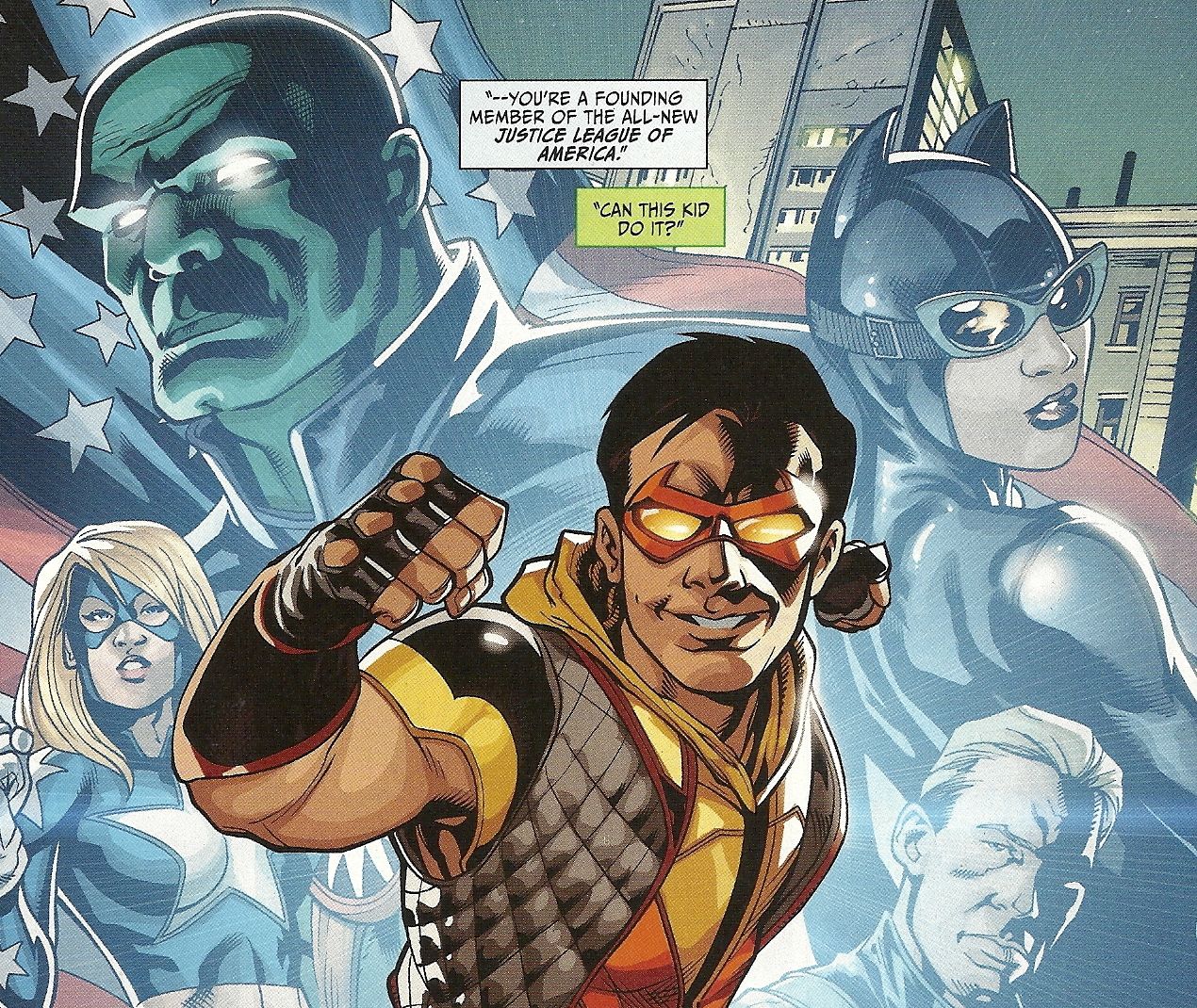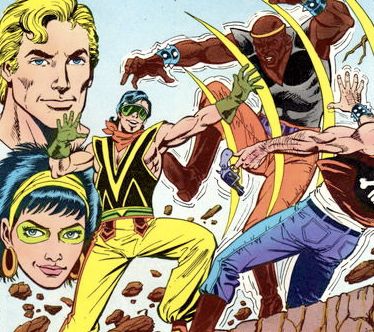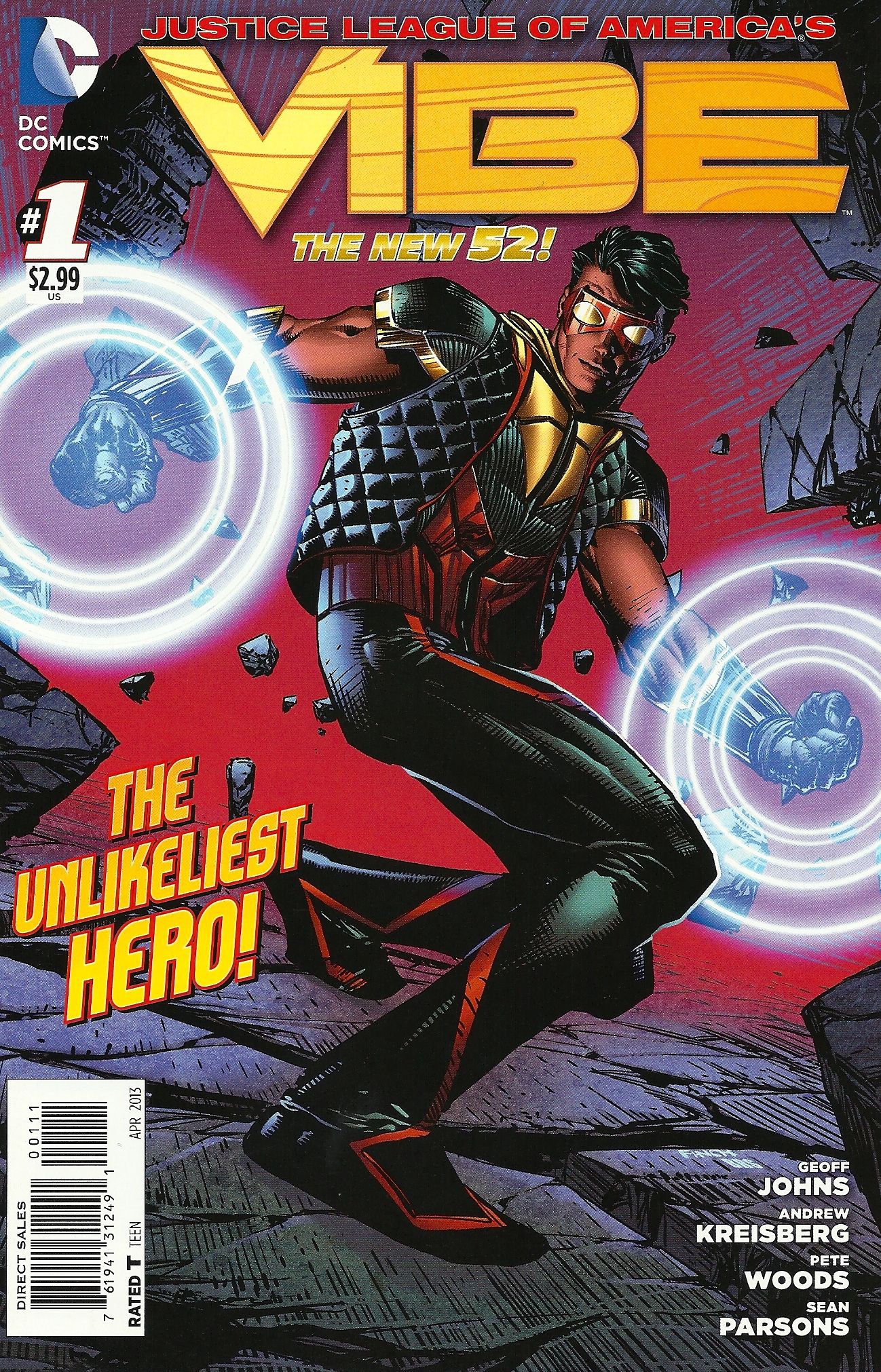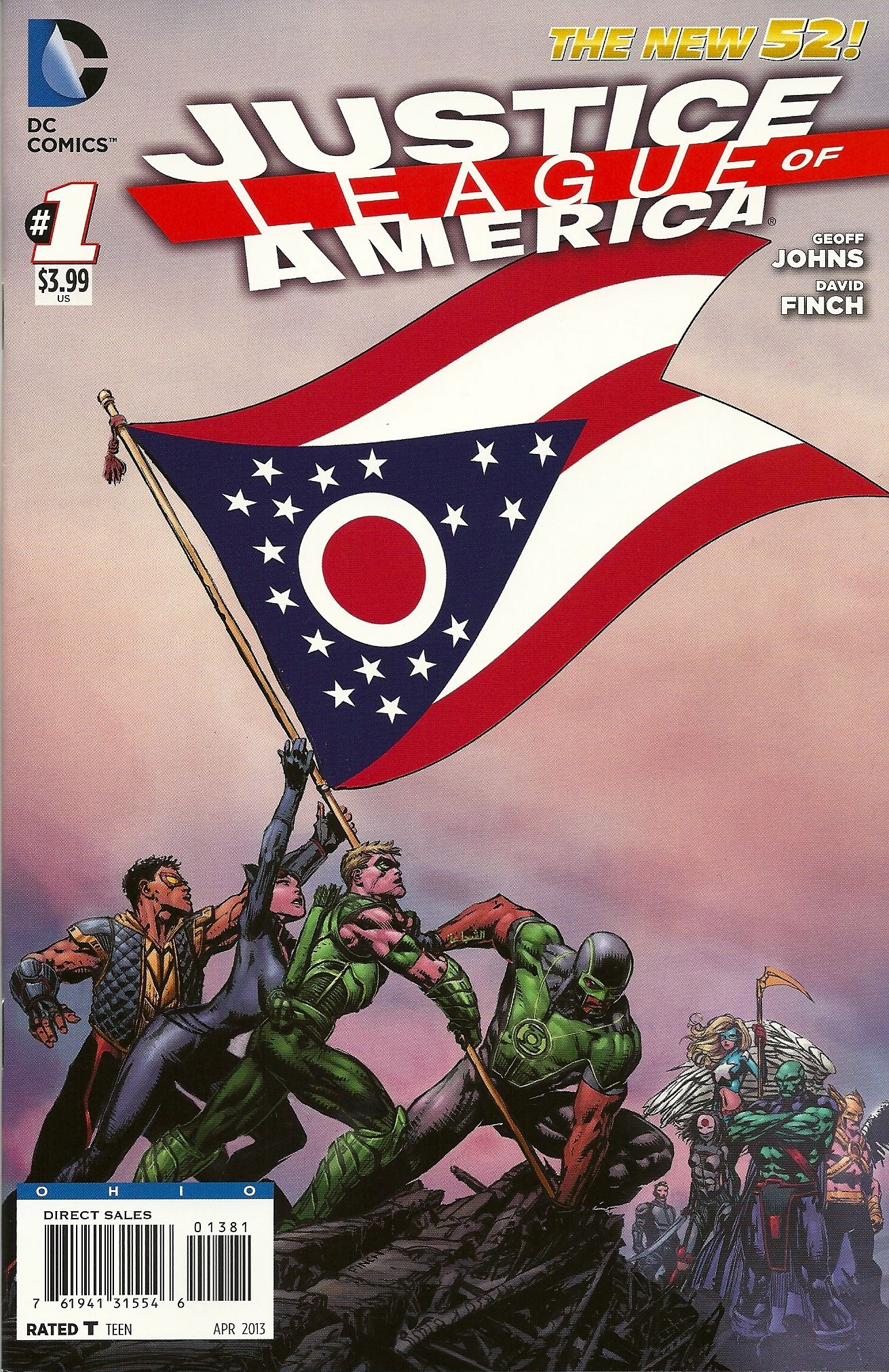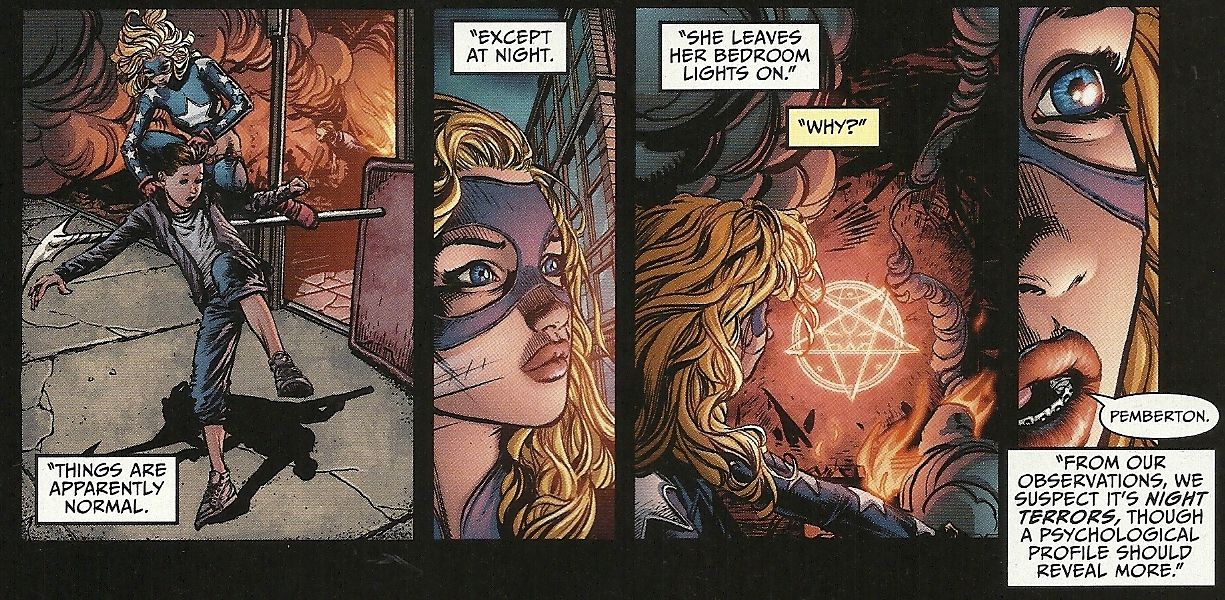Justice League International had respectable sales, but nevertheless was one of the earlier cancellations of DC Comics' New 52. Justice League Dark is similarly doing decent business, but, like JLI, it's still not doing anything close to the monster sales of the Geoff Johns-written flagship Justice League.
So it's not exactly surprising that DC is taking another whack at expanding the Justice League into a franchise, and that for this second attempt, Johns is involved. On Wednesday the publisher debuted Justice League of America and Justice League of America's Vibe, and both will almost certainly be considered successes (the former has more than 50 state-specific variant covers as an added kick in the pants).
But are they good comics? I could answer yes or no, but that would make for an awfully short post. Join me below for a discussion of each.
Vibe was created in 1984 by Gerry Conway and Chuck Patton as part of the ill-starred "Detroit Era" of the Justice League, in which the team relocated from an orbiting satellite headquarters to that city and paired a handful of veterans (Martian Manhunter, Aquaman, Elongated Man and Zatanna) with new heroes (Steel, Gypsy, Vixen).
Vibe was Paco Ramone, an avid breakdancer who previously ran with a gang, and possessed vibrational powers and the unfortunate habit of speaking in phonetically rendered accent (most notably, "you" was always pronounced "chu"). Obviously, he didn't age well, most eloquently evidenced in the fact that he's one of the few dead superheroes to never come back to life (save for a few short stints as a zombie).
DC's not taking any chances with his solo series, titling it Justice League of America's Vibe (when Martian Manhunter received a JLA spinoff in the late '90s, they gave him a "From the Pages of JLA" tag, but didn't force "JLA" into the very title of the book), and writers Geoff Johns and Andrew Kreisberg tie his origin into the events of 2011's Justice League #1 — like Cyborg, he gained his powers by exposure to Darkseid's invaders.
Additionally, Johns and Kreisberg make the obvious-when-you-think-about-it connection regarding vibrational powers and the DC multiverse, which Gardner Fox created and explained as various dimensions existing in the same space, but vibrating at different frequencies (that was how the Flashes used to be able to travel between Earth-1 and Earth-2, for example).
So Vibe is being positioned as a character uniquely qualified to deal with inter-dimensional crises, like Darkseid (who will be coming back in some form, the cliffhanger splash promises) and something "maybe worse" that's been trying to get through. It's safe to say that whenever DC does its eventual big crossover dealing with the nature of their multiverse, as they do on a semi-regular basis, Vibe will be heavily involved.
He's also not as confident or arrogant, but rather he's a industrious teenager who works big-box retail to pay for college and live up to the example his dead big brother set for him. He's not much fun, and I wonder if they ran so far from his now wince-inducing origins that they lost the appealing parts (or potentially appealing parts) of the character.
You know, hip-hop culture still exists, even if the faddish aspects that Vibe exemplified as a sort of clumsy outreach toward youth and relevance have receded.
If I'm talking around the contents of the comic, that is in large part because there's almost nothing here, at least nothing of any interest. Five years ago, Francisco and his two brothers are walking along when one of Darkseid's Parademons appears through a boom tube, killing the eldest and granting Vibe his powers.
One day, an agent of A.R.G.U.S. (The New 52's S.H.I.E.L.D.) shows up to recruit Vibe, telling him he's going to be a member of the new Justice League of America, handing him a new costume and explaining the premise of the series ("So basically you want me to be a ... border cop?") Meanwhile, Skinny Amanda Waller hints at a future threat and that she may not have Vibe's best interests in heart. The end.
Pete Woods provides some rather nice artwork, but it, like the plot, is fairly generic. With so little personality in the writing, the book could have used some energy and style in the art side of the equation, but no dice.
It's hard to see how or if the book will improve, either. Johns is only involved in this issue, and Kreisberg is apparently off the title after three issues, with Sterling Gates coming in for the fourth. Perhaps the "importance" of the character to the fictional setting will keep interest going and, more importantly, eventually add quality, but it's awfully disappointing when compared to, say, 2006's Blue Beetle #1, which also introduced a young Latino hero.
Vibe's role in Justice League of America #1 is fairly small, but it is significant that he and every other member of the team appears in some form within the first issue, quite an improvement over Johns' Justice League #1, which featured Batman and Hal Jordan bickering for most of the issue.
Johns' script here is straightforward, and the plot is almost identical to that of Dan Jurgens' Justice League International #1. Because a governing body isn't so sure it can trust the real Justice League, it wants to create its own own, and it goes through the candidates and arrive on the line-up by the end of the first issue.
In JLI, it was the U.N. Here it's A.R.G.U.S., with Skinny Amanda Waller and Colonel Steve Trevor picking the team. They're all on the cover.
Their secret mission is to be able to take down the Justice League, if it ever comes to that, and so each member is (more or less) selected to combat a particular counterpart on the Justice League, although some of those match-ups seem to be slightly stretching it. (Katana is chosen to counter Wonder Woman, perhaps because she's a woman? I don't know; I didn't read Katana #1 — maybe New 52 Katana is a lot more powerful than old Katana.)
Johns cuts away from the Waller/Trevor discussions to actually show the characters in action, or to involve them in discussions, so while this is basically an assemble-the-team issue, it's got a lot more meat to it than, say, the last , which consisted mostly of Superman, Wonder Woman and Batman looking at headshots.
Professor Ivo, android duplicates of the other Justice League and the Secret Society (of Super-Villains?) are being set up as the antagonists, but it looks like as with most of the New 52 super-stuff, the exciting parts of the books won't be the stories themselves, but seeing what's changed and why.
In that respect, Johns creation Stargirl is probably the most curious character, as she seems to break some of the "rules" of the New 52. She's a legacy tied to Golden Age character (as far as I've seen, the only legacy characters have been ones recreated in the Silver Age and who have been re-decoupled form their antecedents, like The Flash, Green Lantern, Hawkman, etc.).
Stargirl is being positioned as a celebrity superhero, and "Pemberton" (the original Star-Spangled Kid), Pat Duggan (Stripesy) and the rod's original owner (a Starman?) are mentioned in passing.
As for the artwork, I'm not a fan of David Finch. I find his work over-rendered (here, he's inking himself and colored by Sonia Oback and Jeromy Cox), and overly dark. It's very detailed, but the details aren't necessarily important or even consistent.
His women are are all whisper thin and his men indistinguishable, but as long as he's drawing people with costumes and masks, that's not much of a problem. That said, he's a popular artist, so I don't think it matters all that much how good he is; this book is going to sell, and Finch is going to help it do that more than hurt it.
Of course, based on how the Batman title DC created specially for him to write and draw went, chances are Finch isn't going to be drawing this title for very long—or at least, not very often. (The incredible amount of recycled art and imagery in this book, including clipping pieces of his variant cover for Justice League #1 to re-use as headshots, indicates he might already be falling behind). Which is either good news or bad news, depending on what you think of his style and ability.
On the writing side of the equation, this is a much stronger start to a Justice League series than any of the New 52 Justice League series so far, while the art side is predictably weak compared to the work of the artists on those other Justice League comics.
And on the cover? Your state flag!

